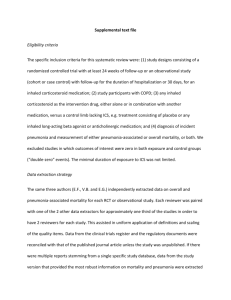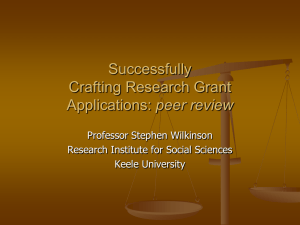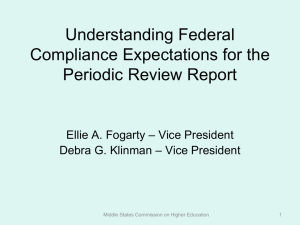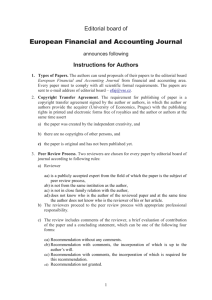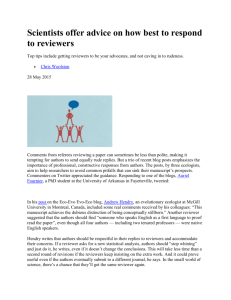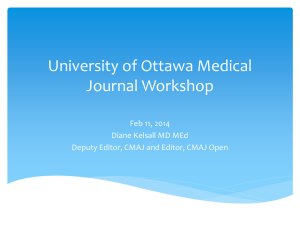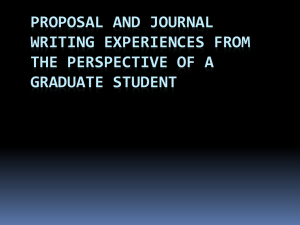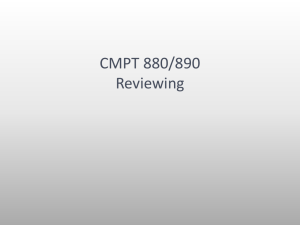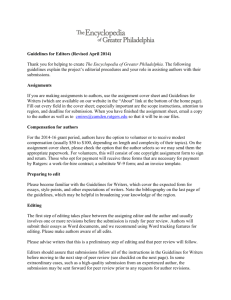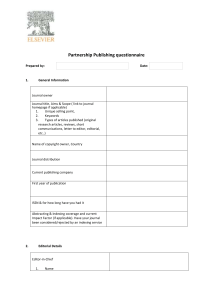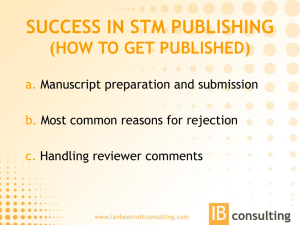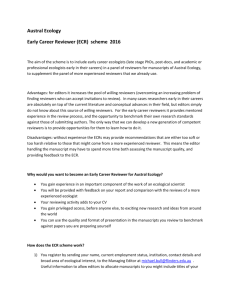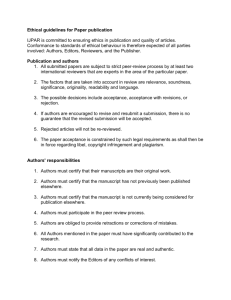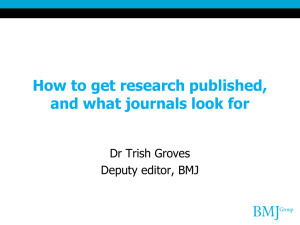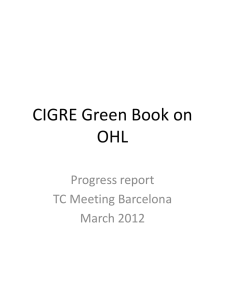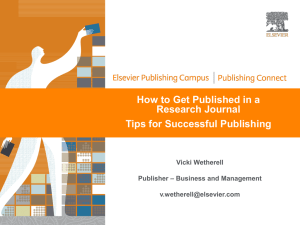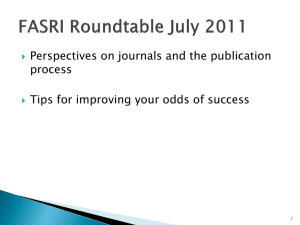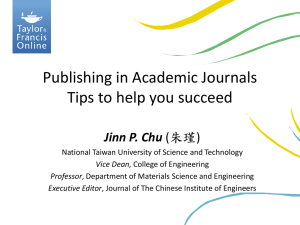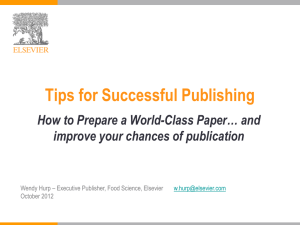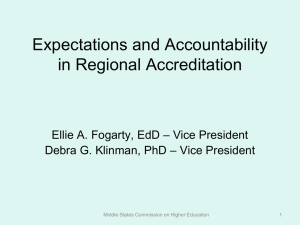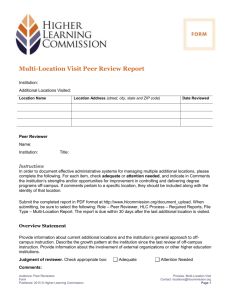PowerPoint for The Publishing Cycle
advertisement
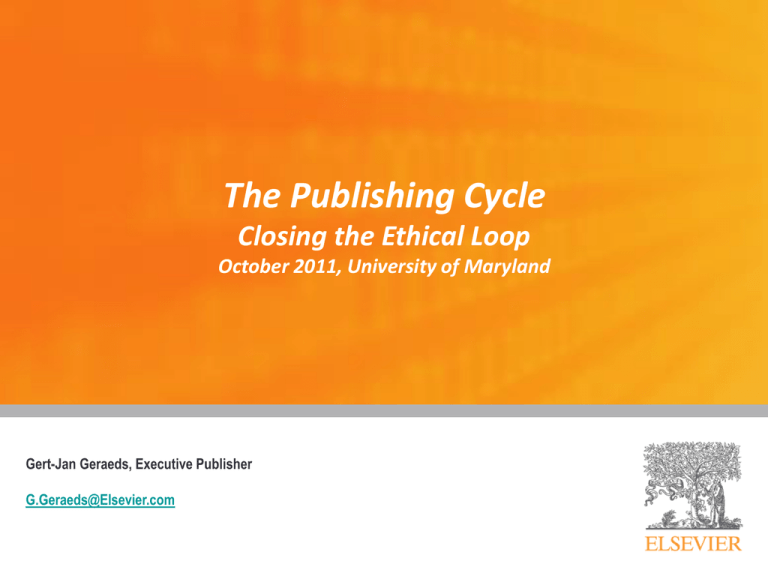
The Publishing Cycle Closing the Ethical Loop October 2011, University of Maryland Gert-Jan Geraeds, Executive Publisher G.Geraeds@Elsevier.com The Journal Publishing Cycle Receive and manage submissions Archive and promote use Manage peer review Publish and disseminate Edit and prepare Production 2 Researchers’ Reasons for Publishing Researchers: which publishing objectives are most important to you? Sources: NOP/Elsevier surveys 2005 and 2010 3 Publish and Perish, if you break the ethical rules 4 International scientific ethics have evolved over centuries and are commonly held throughout the world. Scientific ethics are not considered to have national variants or characteristics – there is a single ethical standard for science. Ethics problems with scientific articles are on the rise globally. How big is the problem? Up to 200,000 of 17 million articles in Medline database may be duplicates, or plagiarized Errami & Garner. Nature 451, 397-399 (2008) 5 Authorship Author: someone who has made substantive intellectual contributions to a published study Authors should make substantial contributions to conception and design, acquisition of data or analysis and interpretation of data draft the article or revise it critically for intellectual content have final approval of the version to be published Definition from: http://www.icmje.org 6 6 Authors’ Duties 7 Reporting Standards Data Access and Retention Originality Multiple or Concurrent Publication Acknowledgement of Sources Hazards and Human or Animal Subjects Disclosure and Conflicts of Interest Fundamental Errors in Published Works Scientific Integrity and Trust Reason for Retraction: During the second revision of the manuscript, the authors modified Figure 1 (changing the label from "Israel" to "Historical Palestine"). The authors did not inform the editors or the publisher of this change in their manuscript. As such, the authors have not lived up to the standards of trust and integrity that form the foundation of the peer-review process. The Editors-in-Chief take a strong view on this matter and, hence, the retraction of the article from publication in Agricultural Water Management. 8 The article of which the authors committed plagiarism will not be removed from ScienceDirect. Everybody who downloads it will see the reason of retraction. 9 Peer Review The essential filter used to separate science from speculation and to determine scientific quality 10 10 Peer review helps to determine the validity, significance and originality of research Helps to improve the quality of papers Publication in peer-reviewed journals protects the author’s work and claim to authorship Publishers have ensured the sustainability of journals and the peer-review system for over 300 years Peer Review is not a Panacea Questions: To what extent do you agree or disagree that the following objectives should be the purpose of peer review To what extent do you agree or disagree that peer review is currently able to do the following? That it selects the best manuscripts for the journal 86 61 92 Determines the originality of the manuscript 64 93 Improves the quality of the published paper 77 81 Ensures previous work is acknowledged 54 Is able 84 Determines the importance of findings 58 81 Detects plagiarism 38 79 Detects fraud 11 Should be able 33 0 10 20 30 40 50 60 70 80 90 100 (n=4037) % agree Reviewers’ Duties 12 Contribution to Editorial Decisions Promptness Confidentiality Objectivity Acknowledgement of Sources Disclosure and Conflict of Interest Peer Review Pilots and Initiatives (1) 1. Re-using reviewer reports Reviewer reports for out-of-scope submissions shared in journal cascading model. Journal consortia re-using reviewer reports 2. Increase efficiency or speed Publish review times per reviewer (Journal of Public Economics) Authors to choose for fast & light review, versus slow & thorough. Authors bypass 2nd review, opting to publish revised paper without 2nd review (BMC Journal of Biology) 3. Increase transparency of peer review Show review reports online (EMBO) Reviewers have the option of revealing their identity (PlosONE) EES: reviewer seeing each other’s reports EES: author seeing editor’s comments 13 Peer Review Pilots and Initiatives (2) 4. Post-publication commenting Nature / Open Peer Review trial (2006) Cell Press 5. Increase chances that reviewers accept invitation Provide monetary incentive (Journal of Public Economics) Empower reviewers: reviewer-finds-article pilot (Chem. Physical Letters) 6. Reward or recognition Publish list of top reviewers in journals Provide best-reviewer certificates 14 Editors’ Duties 15 Publication Decision Fair Play Confidentiality Disclosure and Conflict of Interest Vigilance over Published Record Involvement and Cooperation in Investigations Editorial Guidance or Impact Factor Engineering? EDITOR’S COMMENTS “In general terms, I agree with the reviewers’ comments. However, why did you submit to our journal? It has published various papers on studies in the same line as yours. In the references I have not found one single paper published in our journal, while others were cited various times. In the minor revision, I suggest you check for references published in our journal and add these. This is always a good indicator that a manuscript fits well in a certain journal." 16 Editorial Guidance or Review System Overload? (Desk) Reject Referral New Review Aims & Scope Article Type Quality 17 Reviewers’ Workload Publishers’ Services 18 Publishers coordinate the exchange of ideas between authors, editors, reviewers, and the wider STM audience of researchers, scientists, health professionals, students, and patients. Publisher’s Duties 19 Support Editors, Reviewers and Authors in Performing Ethical Duties Support Editors in the Review of Complaints Develop Codes of Practice and Implement Industry Standards for Best Practice Provide Specialised Legal Review and Counsel Thank You ! Gert-Jan Geraeds, Executive Publisher G.Geraeds@Elsevier.com
